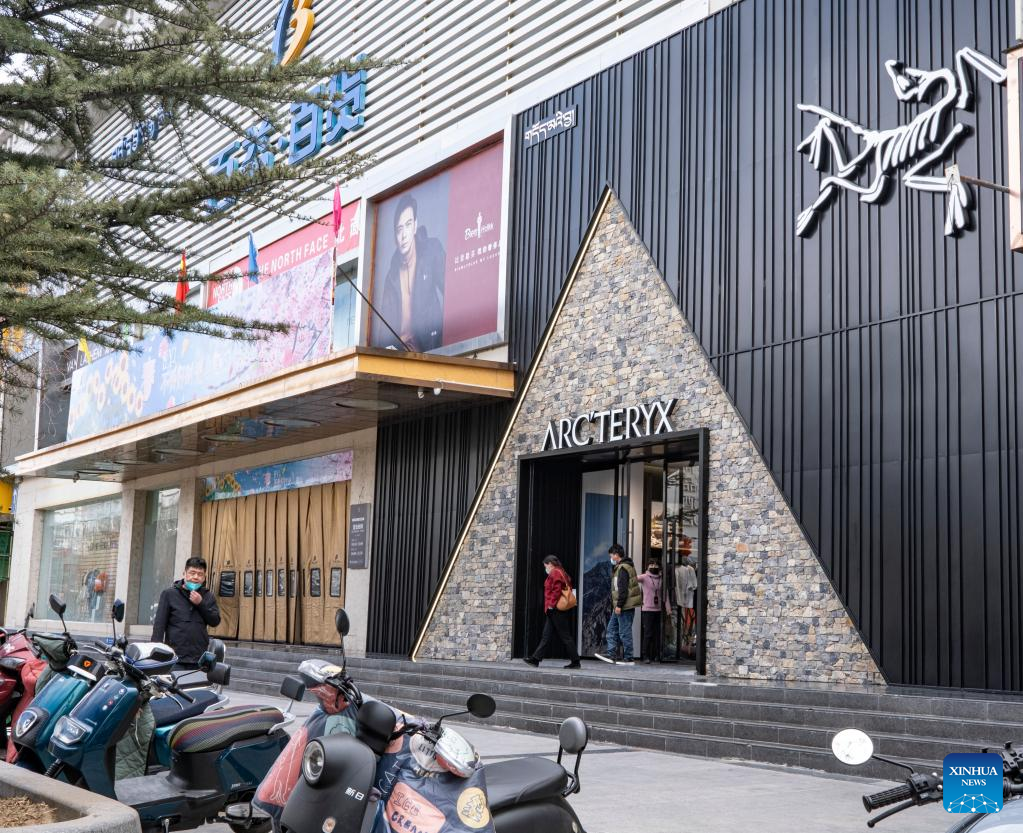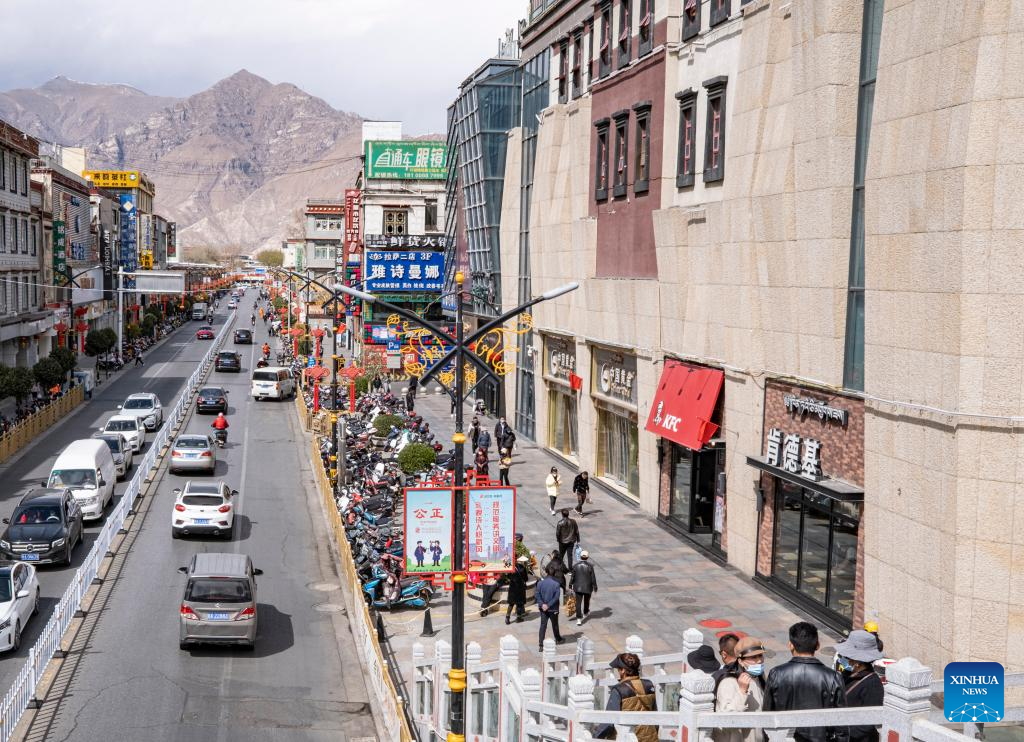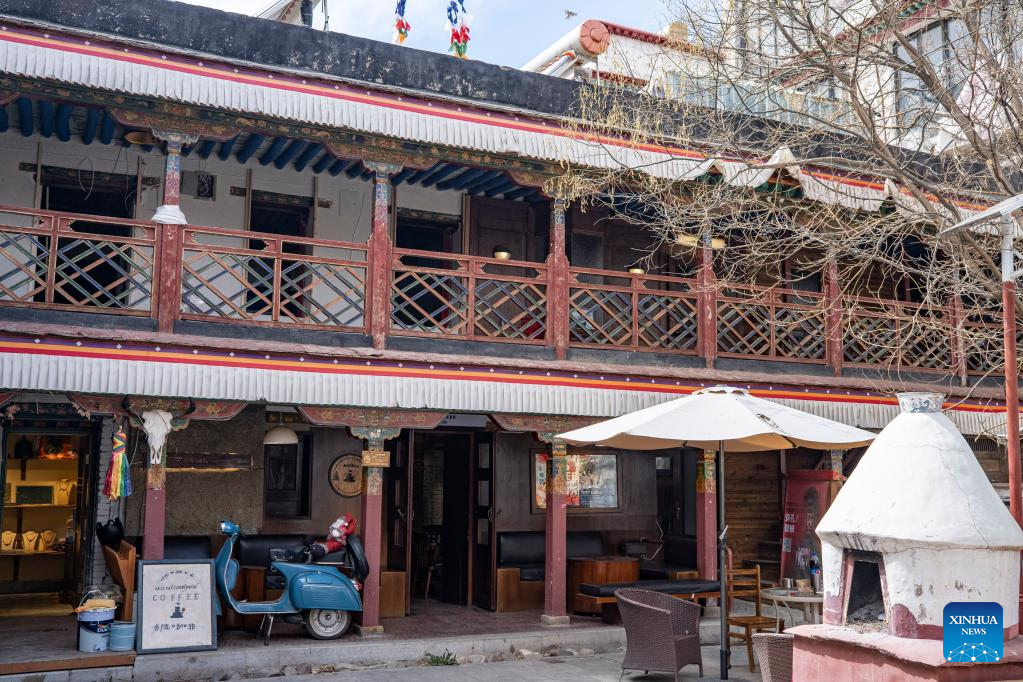
An Arc'Teryx store is pictured on a downtown street of Lhasa, southwest China's Tibet Autonomous Region, March 24, 2023. (Xinhua/Sun Fei)
by Cao Bin
LHASA, March 24 (Xinhua) -- A dear friend of mine once told me how delighted she was to discover a stunning collection of traditional Tibetan rugs while she was browsing through a quaint Buddhist shop nestled in Belgium, adorned with an array of exquisite statues and sacred ritual items.
Meanwhile, on the other side of the world, as I'm walking through the bustling city of Lhasa, I am quite astonished to find imported Belgian chocolates readily available on supermarket shelves here.
These two seemingly unrelated episodes perhaps illustrate the interconnectedness of our world and the beauty of globalization.
As I strolled through the downtown streets of Lhasa, I found international chain restaurants like KFC and Pizza Hut no longer novel, as the Dianping app, the Chinese version of Yelp, indicates at least eight KFC and six Pizza Hut outlets in the city -- more than 3,600 meters above sea level.
KFC was the first big Western fast-food chain to open a branch in Tibet in 2016, while Pizza Hut established its first outlet in 2019. It's quite common to see traditional Tibetan restaurants and their neighboring Western fast-food chains all packed with customers.
To be honest, I never expected the region dubbed "world's third pole" to be so closely connected with the world.
According to Lhasa customs, the Tibet Autonomous Region engaged in trade with 95 countries and regions around the globe in 2022, up by 18 from the previous year.
Its traditional products, like Tibetan rugs and handicrafts, are exported, while stores selling imported products can be seen every few hundred meters in downtown Lhasa.
Right across the street from my workplace, there's an Indian mini-market, brimming with a diverse range of products.
From Indian scarves, hair essential oils and perfumes to sweets from Japan, biscuits from Russia, vegetable noodles from Vietnam, baking soda from the United States, and instant cereal from Malaysia, there is an impressive array of international goods on display.
What's even more intriguing is that similar shops with Nepalese or Korean products can be found all around the streets of Lhasa. It's fascinating to witness how a city once considered remote and inaccessible from the rest of the world is now bustling with commerce and global trade.
As I perused the shelves of a downtown supermarket, I was taken aback by the sight of fresh cherries from Chile and Musang King durians from Malaysia. It was a surprise, as I had assumed that the logistics of transporting goods to the "roof of the world" would be quite challenging.
I later learned from an express delivery truck driver that a single trip between Lhasa and Chengdu, capital of the neighboring Sichuan Province, can take up to 60 hours. This revelation gave me a newfound appreciation for the incredible effort required to bring these exotic fruits to Lhasa.
As my day of tourism odyssey was drawing to a close, I entered the newly opened shopping mall and made a beeline for the Arc'Teryx store. The salesman eagerly showcased the latest spring styles, proudly proclaiming that they were "the same as the ones in New York and Hong Kong." I couldn't help but be impressed by the global reach of high-end outdoor and extreme sports brands, all competing for a foothold in the thriving city of Lhasa.
It's clear that the city is experiencing a boom in commerce and tourism, with even Barkhor Street -- traditionally a spot for pilgrims to visit the Jokhang Temple -- now also attracting aficionados of cocktails and coffee. This blending of cultures and interests is emblematic of the dynamic and rapidly evolving landscape of modern Lhasa.
I vividly recall the time I stumbled upon an unexpected treasure in the heart of the city. While passing by a shoe shop, I accidentally found myself in an ancient courtyard under state protection. There, I discovered a cocktail bar that perfectly melded ancient Tibetan decorations with modern design.
Wow! Moscow Mule, Negroni ... I saw almost all well-known cocktails on the menu. The bartenders, impeccably groomed and brimming with humor and confidence, transported me back to my memories of drinking in first-tier cities like Beijing and Shanghai. As I savored my drink, I felt grateful for the opportunity to explore new horizons and embrace the unique charm of modern Lhasa.
In recent years, boutique coffee shops have proliferated like mushrooms after rain. If you search for "coffee shop" on Dianping in Lhasa, you will discover over 1,300 results.
Although traditional sweet tea and yak butter tea are still the mainstay in Lhasa, it is not bad smelling the fragrance of coffee through the streets, and a large variety of coffee beans are available here.
Without a moment's hesitation, I indulged in a cup of Tibetan cheese mocha. Heavenly! With chewy bits of cheese infused within, the mocha boasts a rich flavor profile and leaves a lingering aroma in the mouth -- a perfect combination of traditional and modern elements. ■

A KFC branch is pictured on a downtown street of Lhasa, southwest China's Tibet Autonomous Region, March 24, 2023. (Xinhua/Sun Fei)

A coffee bar is pictured near Barkhor Street in Lhasa, southwest China's Tibet Autonomous Region, March 24, 2023. (Xinhua/Sun Fei)

An Indian mini-market is pictured in Lhasa, southwest China's Tibet Autonomous Region, March 24, 2023. (Xinhua/Sun Fei)



